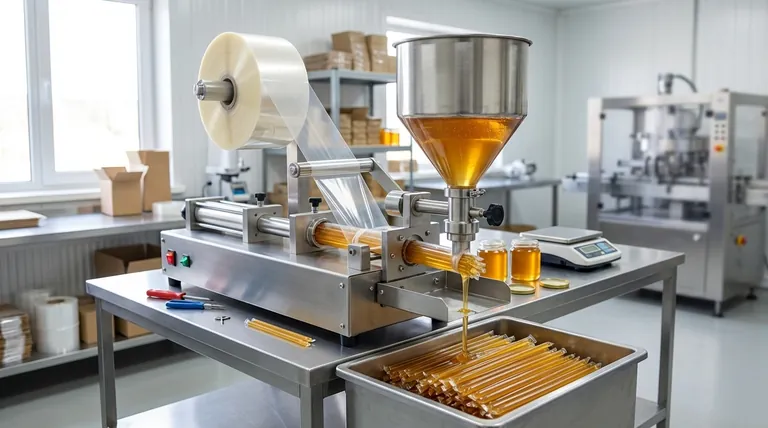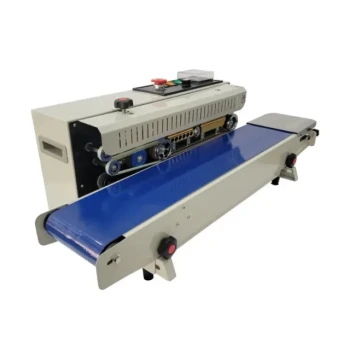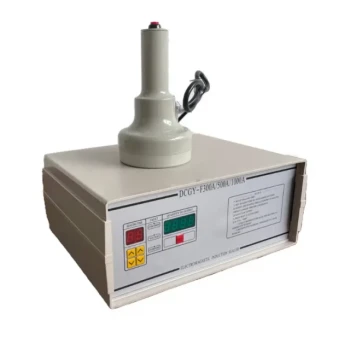In essence, a honey stick machine is a specialized form-fill-seal packaging system. It is designed to take a liquid product like honey and precisely package it into narrow, single-serving plastic tubes, often called honey sticks or straws. This automated process transforms bulk honey into a convenient, portable, and highly marketable consumer product.
The core decision is not simply if you need a honey stick machine, but which type of machine aligns with your specific production scale, market strategy, and budget. Choosing the right equipment is a strategic investment in efficiency and brand positioning.

How a Honey Stick Machine Works
A honey stick machine automates a sequence of operations that turn a roll of plastic film and a vat of honey into finished, sealed sticks ready for distribution.
The Core Process: Film to Stick
The process begins with a large roll of packaging film, which is fed from an unwinding disk. The film is guided over rollers and folded into a tube shape by a forming tube.
At the same time, honey is held in a heated hopper to maintain its viscosity. A piston pump then injects a precise, measured amount of honey into the formed tube.
Sealing and Filling in Sequence
Once the tube is filled, a vertical sealing bar creates the long seam along the length of the stick. Next, a horizontal sealing bar clamps down, creating the top seal of one stick and the bottom seal of the next one simultaneously.
The Final Cut
Located within the horizontal sealing bar is a sharp cutter. This blade activates after the horizontal seal is made, cleanly separating the filled and sealed honey stick from the continuous tube of film, allowing the cycle to repeat.
Understanding the Different Types of Machines
Not all honey stick machines are the same. The right model depends entirely on your production goals.
The Standard Machine: The Workhorse
The standard honey stick machine is the most common type. It produces typical sticks, usually 6-7 inches long, and is the foundation of many small to medium-sized operations. It offers a great balance of affordability and efficiency.
The Shaped Machine: For Market Appeal
A shaped honey stick machine uses custom dies to create unique shapes or stylized seals on the ends of the sticks. This is a powerful tool for branding and attracting specific demographics, like children, but requires a higher initial investment.
The Twin Machine: For Doubled Throughput
A twin honey stick machine features two hoppers and two filling nozzles. It produces two attached sticks at once, effectively doubling the output of a standard machine. Some models can even fill two different products, like honey and a complementary flavor, into the conjoined sticks.
The Automatic Machine: For Mass Production
Designed for large-scale industrial operations, the fully automatic honey stick machine is a multi-lane system. It can produce hundreds of sticks per minute with minimal operator intervention, handling everything from film loading to final output.
Understanding the Trade-offs
While highly efficient, investing in a honey stick machine involves clear trade-offs that must be considered.
Initial Investment Cost
The primary trade-off is capital expenditure. A basic, standard machine is relatively affordable, but the cost increases significantly for shaped, twin, or fully automatic multi-lane systems. You are paying for speed, customization, and automation.
Space and Infrastructure Requirements
A simple machine may have a small footprint, but a high-speed automatic machine requires substantial floor space. It also demands more robust power and potentially compressed air infrastructure to operate effectively.
Operational Flexibility vs. Complexity
Standard machines are often simpler to operate and maintain. Advanced models with HMI touch screens and multi-lane configurations offer incredible control and efficiency but come with a steeper learning curve and more complex maintenance needs.
Making the Right Choice for Your Production Goals
Your choice of machine should be driven by a clear business objective.
- If your primary focus is starting a small-batch, artisanal business: A standard honey stick machine provides the most cost-effective entry point for producing a quality product.
- If your primary focus is brand differentiation in a competitive market: A shaped machine is a strategic investment to create a unique product that stands out on the shelf.
- If your primary focus is scaling up to meet high-volume retail or wholesale demand: A twin or fully automatic multi-lane machine is the only way to achieve the necessary throughput and efficiency.
Ultimately, selecting the correct honey stick machine empowers you to turn a simple natural product into a convenient, profitable, and in-demand consumer good.
Summary Table:
| Machine Type | Best For | Key Feature |
|---|---|---|
| Standard | Small to medium operations | Balance of affordability & efficiency |
| Shaped | Brand differentiation & market appeal | Custom dies for unique end seals |
| Twin | Doubling output or dual flavors | Two nozzles for two attached sticks |
| Automatic | Large-scale, high-volume production | Multi-lane, minimal operator input |
Ready to scale your honey packaging operation?
At HONESTBEE, we supply commercial apiaries and beekeeping equipment distributors with the right honey stick machines for their specific production goals. Our expertise ensures you get the efficient, reliable equipment you need to maximize your profitability.
Contact our wholesale experts today to discuss the best machine for your business!
Visual Guide

Related Products
- Automatic Honey Filling and Filtering Machine for Beekeeping Bottle Filling
- Pneumatic Paste Filling Machine Bottling Packaging Machine Single Nozzle
- Precision Durable Efficient HONESTBEE Rotary Honey Filling Machine
- Pneumatic Double Nozzle Honey Filling Bottling Packaging Machine
- Automatic Continuous Heat Sealing Machine
People Also Ask
- What bottling equipment is used after honey filtering? Choose the Right System for Your Scale
- What features do honey stick filling machines offer? Automate Production for Perfect Sticks
- How does automation in honey filling reduce labor costs? Boost Efficiency & Cut Costs by 30%
- How does the feeding system work in automated honey filling machines? A Guide to Viscosity & Volume
- What is the filling accuracy of an automatic honey filling machine? Achieve ±0.5% Precision for Your Apiary



















